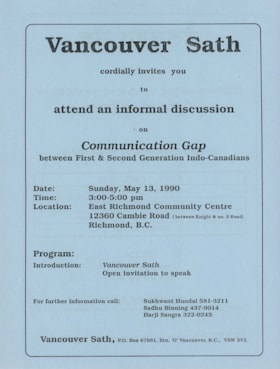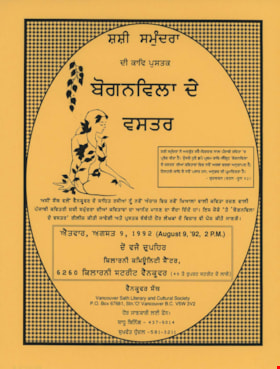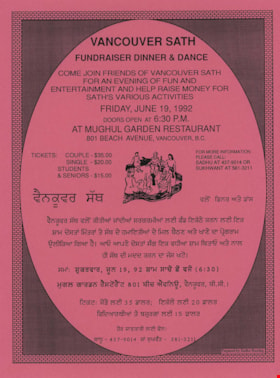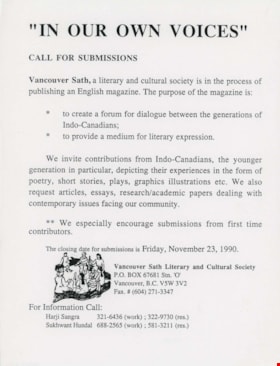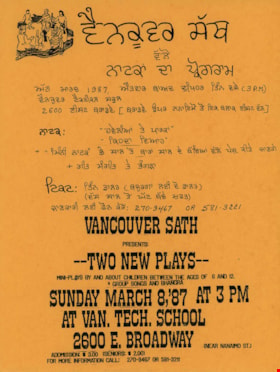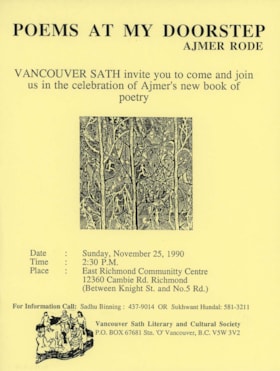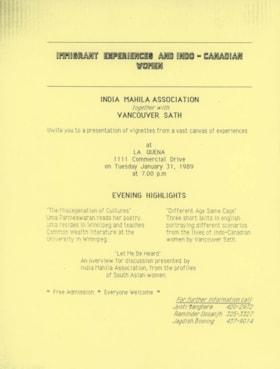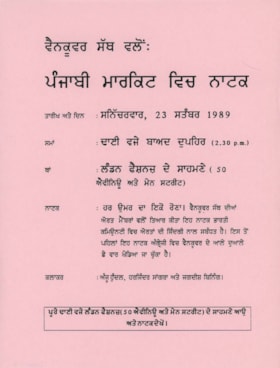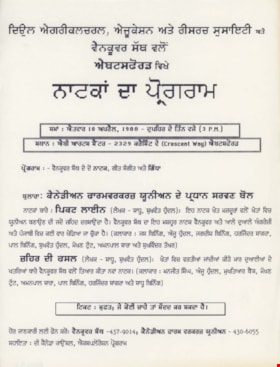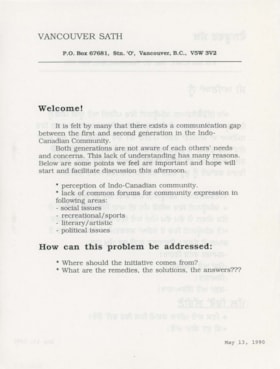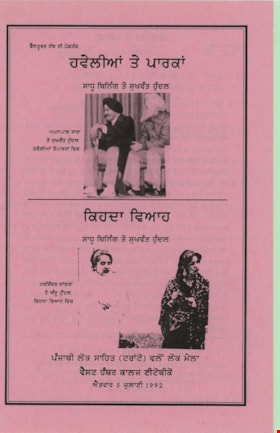More like 'Jewels of the Qila : the remarkable story of an Indo-Canadian family'
Narrow Results By
Decade
- 2020s 62
- 2010s 42
- 2000s 46
- 1990s 72
- 1980s 55
- 1970s 311
- 1960s 65
- 1950s 117
- 1940s 120
- 1930s 81
- 1920s 60
- 1910s 21
- 1900s 20
- 1890s 4
- 1880s 1
- 1870s 2
- 1860s 1
- 1850s 1
- 1840s 1
- 1830s 2
- 1820s 1
- 1810s 1
- 1800s 1
- 1790s 1
- 1780s 1
- 1770s 1
- 1760s 1
- 1750s 1
- 1740s 1
- 1730s 1
- 1720s 1
- 1710s 1
- 1700s 1
- 1690s 1
- 1680s 1
- 1670s 1
- 1660s 1
- 1650s 1
- 1640s 1
- 1630s 1
- 1620s 1
- 1610s 1
- 1600s 1
Subject
- Adornment 4
- Adornment - Jewelry 1
- Adornment - Lapel Pins 3
- Advertising Medium 4
- Advertising Medium - Poster 1
- Advertising Medium - Signs and Signboards 6
- Aerial Photographs 1
- Agricultural Tools and Equipment 3
- Agricultural Tools and Equipment - Gardening Equipment 1
- Agriculture 8
- Agriculture - Crops 3
- Agriculture - Farms 31
Fire at Kapoor Sawmills Ltd.
https://search.heritageburnaby.ca/link/museumdescription15207
- Repository
- Burnaby Village Museum
- Date
- 14 Jan.1947 (date of original), copied 2004
- Collection/Fonds
- In the Shadow by the Sea collection
- Description Level
- Item
- Physical Description
- 1 photograph (tiff) : 300 dpi
- Scope and Content
- Photograph of a fire that destroyed the Kapoor Sawmills Limited in January 1947. A group of bystanders are looking on while firefighters from the Burnaby Fire Department fight the blaze.
- Repository
- Burnaby Village Museum
- Collection/Fonds
- In the Shadow by the Sea collection
- Description Level
- Item
- Physical Description
- 1 photograph (tiff) : 300 dpi
- Scope and Content
- Photograph of a fire that destroyed the Kapoor Sawmills Limited in January 1947. A group of bystanders are looking on while firefighters from the Burnaby Fire Department fight the blaze.
- History
- Kapoor Singh Siddoo was born in 1885 in the Punjab village of Kharaudi, India. Kapoor was one of the pioneer South Asian Canadian Sikhs who immigrated to America in 1906 and onto Canada in 1912. Kapoor first arrived in San Francisco in 1906, along with twenty uneducated men from the Province of Punjab, India. Kapoor was the only one among these men who was educated so acted as their interpreter, manager and accountant. They worked along the Southern Pacific Railway line near Marysville, California, toward Reno and Nevada. Kapoor heard about the beauty of British Columbia and decided to travel to the west coast but times were tough with discrimination against all South Asians in British Columbia. With this information, Kapoor traveled east to Northern Ontario where he tried homesteading for a year but the extreme winter conditions didn’t appeal to him. Kapoor returned to British Columbia after receiving word from South Asian Canadians that they were in need of an educated accountant/manager for a sawmill. In 1923, with the change in immigration laws, Kapoor arranged for his wife, Besant Kaur to emigrate from India. Besant came to Canada accompanied by Kapoor’s older brother. Kapoor and Besant had two daughters, both born in Duncan B.C. Jagdis Kaur Siddoo was born in 1925 and Sarjit Kaur Siddoo was born in 1926. Both of their daughters graduated as doctors from University of Toronto medical school. His career in B.C. began as a lumberman for a large lumber mill on Vancouver Island until 1935. Following this, Kapoor established the Kapoor Lumber Company Limited and operated a mill at Shawnigan Lake before eventually purchasing 45 acres in 1939 of the eastern section of the former Barnet Mill site in Burnaby. He purchased the site from the Municipality of Burnaby under the name of Modern Sawmills Limited since there was a restriction on selling this piece of a property to a non-white person. Eventually the name was changed to Kapoor Sawmills Limited. Kapoor’s company was a financial success but was tragically razed on January 14, 1947 due to a devastating fire. A smaller mill was rebuilt on the site and Kapoor maintained a successful financial operation until 1959. In 1959, Kapoor Siddoo was considered one of Vancouver’s most influential men in the South Asian Community. In this same year, the family set up the Kapoor Singh Siddoo Foundation and with help from his wife and daughters opened a hospital in the Punjab village of Aur. In 1964, Kapoor died in India at the age of 79 years. Kapoor’s younger brother, Tara Singh Siddoo came to Canada from India in 1906 but after suffering discrimination, he returned to India in 1912. Several years later Tara returned to Canada joining Kapoor at a logging mill on Vancouver Island. Lesser shares of the mill were held by Tara and other family members. Tara and his wife, Beant Siddoo lived at Barnet between 1943 and 1945, with their family of five sons, Lakhbeer, Gurdeb, Gurcharn, Baldev, Hardev and three daughters, Harjeet (Sangha), Runjeet (Basi) and Buckshish (Sarai). One of Tara’s responsibilities was to oversee the logging camp and ensure that the logs arrived regularly from Cowichan Bay near Duncan to the Barnet logging mill.
- Subjects
- Industries - Logging/lumber
- Natural Phenomena - Fires
- Occupations - Fire Fighters
- Persons - South Asian Canadians
- Geographic Access
- Burrard Inlet
- Barnet Marine Park
- Accession Code
- BV019.32.28
- Access Restriction
- No restrictions
- Reproduction Restriction
- May be restricted by third party rights
- Date
- 14 Jan.1947 (date of original), copied 2004
- Media Type
- Photograph
- Historic Neighbourhood
- Barnet (Historic Neighbourhood)
- Planning Study Area
- Burnaby Mountain Area
- Notes
- Title based on contents of photograph
- Information from page 6 of The Province newspaper-Jan. 15, 1947 confirms that the fire occurred on Tuesday January 14, 1947
- See page 67 of book "In the Shadow by the Sea - Recollections of Burnaby's Barnet Village". Caption with photograph reads: "The February, 1947 Kapoor Sawmill fire. Maintenance workers were trying to thaw out frozen bearings on a machine with a blowtorch and inadvertently started a fire in oily shavings. all the water pipes were frozen preventing the workers from dousing the intital small flames. Finally, but too late to prevent the mill's destruction, water was pumped in from the inlet by the Burnaby Fire Department."
Images
Fire at Kapoor Sawmills Ltd.
https://search.heritageburnaby.ca/link/museumdescription15209
- Repository
- Burnaby Village Museum
- Date
- 14 Jan.1947 (date of original), copied 2004
- Collection/Fonds
- In the Shadow by the Sea collection
- Description Level
- Item
- Physical Description
- 1 photograph (tiff) : 300 dpi
- Scope and Content
- Photograph of a fire at the Kapoor Sawmills Limited on January 14, 1947. Mill buildings are engulfed in flames. There is snow on the ground.
- Repository
- Burnaby Village Museum
- Collection/Fonds
- In the Shadow by the Sea collection
- Description Level
- Item
- Physical Description
- 1 photograph (tiff) : 300 dpi
- Scope and Content
- Photograph of a fire at the Kapoor Sawmills Limited on January 14, 1947. Mill buildings are engulfed in flames. There is snow on the ground.
- History
- Kapoor Singh Siddoo was born in 1885 in the Punjab village of Kharaudi, India. Kapoor was one of the pioneer South Asian Canadian Sikhs who immigrated to America in 1906 and onto Canada in 1912. Kapoor first arrived in San Francisco in 1906, along with twenty uneducated men from the Province of Punjab, India. Kapoor was the only one among these men who was educated so acted as their interpreter, manager and accountant. They worked along the Southern Pacific Railway line near Marysville, California, toward Reno and Nevada. Kapoor heard about the beauty of British Columbia and decided to travel to the west coast but times were tough with discrimination against all South Asians in British Columbia. With this information, Kapoor traveled east to Northern Ontario where he tried homesteading for a year but the extreme winter conditions didn’t appeal to him. Kapoor returned to British Columbia after receiving word from South Asian Canadians that they were in need of an educated accountant/manager for a sawmill. In 1923, with the change in immigration laws, Kapoor arranged for his wife, Besant Kaur to emigrate from India. Besant came to Canada accompanied by Kapoor’s older brother. Kapoor and Besant had two daughters, both born in Duncan B.C. Jagdis Kaur Siddoo was born in 1925 and Sarjit Kaur Siddoo was born in 1926. Both of their daughters graduated as doctors from University of Toronto medical school. His career in B.C. began as a lumberman for a large lumber mill on Vancouver Island until 1935. Following this, Kapoor established the Kapoor Lumber Company Limited and operated a mill at Shawnigan Lake before eventually purchasing 45 acres in 1939 of the eastern section of the former Barnet Mill site in Burnaby. He purchased the site from the Municipality of Burnaby under the name of Modern Sawmills Limited since there was a restriction on selling this piece of a property to a non-white person. Eventually the name was changed to Kapoor Sawmills Limited. Kapoor’s company was a financial success but was tragically razed on January 14, 1947 due to a devastating fire. A smaller mill was rebuilt on the site and Kapoor maintained a successful financial operation until 1959. In 1959, Kapoor Siddoo was considered one of Vancouver’s most influential men in the South Asian Community. In this same year, the family set up the Kapoor Singh Siddoo Foundation and with help from his wife and daughters opened a hospital in the Punjab village of Aur. In 1964, Kapoor died in India at the age of 79 years. Kapoor’s younger brother, Tara Singh Siddoo came to Canada from India in 1906 but after suffering discrimination, he returned to India in 1912. Several years later Tara returned to Canada joining Kapoor at a logging mill on Vancouver Island. Lesser shares of the mill were held by Tara and other family members. Tara and his wife, Beant Siddoo lived at Barnet between 1943 and 1945, with their family of five sons, Lakhbeer, Gurdeb, Gurcharn, Baldev, Hardev and three daughters, Harjeet (Sangha), Runjeet (Basi) and Buckshish (Sarai). One of Tara’s responsibilities was to oversee the logging camp and ensure that the logs arrived regularly from Cowichan Bay near Duncan to the Barnet logging mill.
- Geographic Access
- Burrard Inlet
- Barnet Marine Park
- Accession Code
- BV019.32.29
- Access Restriction
- No restrictions
- Reproduction Restriction
- May be restricted by third party rights
- Date
- 14 Jan.1947 (date of original), copied 2004
- Media Type
- Photograph
- Historic Neighbourhood
- Barnet (Historic Neighbourhood)
- Planning Study Area
- Burnaby Mountain Area
- Notes
- Title based on contents of photograph
- Information from page 6 of The Province newspaper-Jan. 15, 1947 confirms that the fire occurred on Tuesday January 14, 1947
Images
Fire fighters battling fire at Kapoor Sawmills Ltd.
https://search.heritageburnaby.ca/link/museumdescription15203
- Repository
- Burnaby Village Museum
- Date
- 14 Jan. 1947 (date of original), copied 2004
- Collection/Fonds
- In the Shadow by the Sea collection
- Description Level
- Item
- Physical Description
- 1 photograph (tiff) : 300 dpi
- Scope and Content
- Photograph of firefighters from the Burnaby Fire Department battling the fire that destroyed the Kapoor Sawmills Limited in January 1947. Water was pumped from Burrard Inlet to fight the fire.
- Repository
- Burnaby Village Museum
- Collection/Fonds
- In the Shadow by the Sea collection
- Description Level
- Item
- Physical Description
- 1 photograph (tiff) : 300 dpi
- Scope and Content
- Photograph of firefighters from the Burnaby Fire Department battling the fire that destroyed the Kapoor Sawmills Limited in January 1947. Water was pumped from Burrard Inlet to fight the fire.
- History
- Kapoor Singh Siddoo was born in 1885 in the Punjab village of Kharaudi, India. Kapoor was one of the pioneer South Asian Canadian Sikhs who immigrated to America in 1906 and onto Canada in 1912. Kapoor first arrived in San Francisco in 1906, along with twenty uneducated men from the Province of Punjab, India. Kapoor was the only one among these men who was educated so acted as their interpreter, manager and accountant. They worked along the Southern Pacific Railway line near Marysville, California, toward Reno and Nevada. Kapoor heard about the beauty of British Columbia and decided to travel to the west coast but times were tough with discrimination against all South Asians in British Columbia. With this information, Kapoor traveled east to Northern Ontario where he tried homesteading for a year but the extreme winter conditions didn’t appeal to him. Kapoor returned to British Columbia after receiving word from South Asian Canadians that they were in need of an educated accountant/manager for a sawmill. In 1923, with the change in immigration laws, Kapoor arranged for his wife, Besant Kaur to emigrate from India. Besant came to Canada accompanied by Kapoor’s older brother. Kapoor and Besant had two daughters, both born in Duncan B.C. Jagdis Kaur Siddoo was born in 1925 and Sarjit Kaur Siddoo was born in 1926. Both of their daughters graduated as doctors from University of Toronto medical school. His career in B.C. began as a lumberman for a large lumber mill on Vancouver Island until 1935. Following this, Kapoor established the Kapoor Lumber Company Limited and operated a mill at Shawnigan Lake before eventually purchasing 45 acres in 1939 of the eastern section of the former Barnet Mill site in Burnaby. He purchased the site from the Municipality of Burnaby under the name of Modern Sawmills Limited since there was a restriction on selling this piece of a property to a non-white person. Eventually the name was changed to Kapoor Sawmills Limited. Kapoor’s company was a financial success but was tragically razed on January 14, 1947 due to a devastating fire. A smaller mill was rebuilt on the site and Kapoor maintained a successful financial operation until 1959. In 1959, Kapoor Siddoo was considered one of Vancouver’s most influential men in the South Asian Community. In this same year, the family set up the Kapoor Singh Siddoo Foundation and with help from his wife and daughters opened a hospital in the Punjab village of Aur. In 1964, Kapoor died in India at the age of 79 years. Kapoor’s younger brother, Tara Singh Siddoo came to Canada from India in 1906 but after suffering discrimination, he returned to India in 1912. Several years later Tara returned to Canada joining Kapoor at a logging mill on Vancouver Island. Lesser shares of the mill were held by Tara and other family members. Tara and his wife, Beant Siddoo lived at Barnet between 1943 and 1945, with their family of five sons, Lakhbeer, Gurdeb, Gurcharn, Baldev, Hardev and three daughters, Harjeet (Sangha), Runjeet (Basi) and Buckshish (Sarai). One of Tara’s responsibilities was to oversee the logging camp and ensure that the logs arrived regularly from Cowichan Bay near Duncan to the Barnet logging mill.
- Subjects
- Industries - Logging/lumber
- Natural Phenomena - Fires
- Occupations - Fire Fighters
- Persons - South Asian Canadians
- Geographic Access
- Burrard Inlet
- Barnet Marine Park
- Accession Code
- BV019.32.24
- Access Restriction
- No restrictions
- Reproduction Restriction
- May be restricted by third party rights
- Date
- 14 Jan. 1947 (date of original), copied 2004
- Media Type
- Photograph
- Historic Neighbourhood
- Barnet (Historic Neighbourhood)
- Planning Study Area
- Burnaby Mountain Area
- Notes
- Title based on contents of photograph
- Information from page 6 of The Province newspaper-Jan. 15, 1947 confirms that the fire occurred on January 14, 1947
- See page 67 of book "In the Shadow by the Sea - Recollections of Burnaby's Barnet Village". Caption with photograph reads: "The February, 1947 Kapoor Sawmill fire. Maintenance workers were trying to thaw out frozen bearings on a machine with a blowtorch and inadvertently started a fire in oily shavings. all the water pipes were frozen preventing the workers from dousing the intital small flames. Finally, but too late to prevent the mill's destruction, water was pumped in from the inlet by the Burnaby Fire Department."
Images
Fire fighters battling fire at Kapoor Sawmills Ltd.
https://search.heritageburnaby.ca/link/museumdescription15204
- Repository
- Burnaby Village Museum
- Date
- 14 Jan. 1947 (date of original), copied 2004
- Collection/Fonds
- In the Shadow by the Sea collection
- Description Level
- Item
- Physical Description
- 1 photograph (tiff) : 300 dpi
- Scope and Content
- Photograph of firefighters from the Burnaby Fire Department battling the fire that destroyed the Kapoor Sawmills Limited in January 1947. Water was pumped from Burrard Inlet to fight the fire.
- Repository
- Burnaby Village Museum
- Collection/Fonds
- In the Shadow by the Sea collection
- Description Level
- Item
- Physical Description
- 1 photograph (tiff) : 300 dpi
- Scope and Content
- Photograph of firefighters from the Burnaby Fire Department battling the fire that destroyed the Kapoor Sawmills Limited in January 1947. Water was pumped from Burrard Inlet to fight the fire.
- History
- Kapoor Singh Siddoo was born in 1885 in the Punjab village of Kharaudi, India. Kapoor was one of the pioneer South Asian Canadian Sikhs who immigrated to America in 1906 and onto Canada in 1912. Kapoor first arrived in San Francisco in 1906, along with twenty uneducated men from the Province of Punjab, India. Kapoor was the only one among these men who was educated so acted as their interpreter, manager and accountant. They worked along the Southern Pacific Railway line near Marysville, California, toward Reno and Nevada. Kapoor heard about the beauty of British Columbia and decided to travel to the west coast but times were tough with discrimination against all South Asians in British Columbia. With this information, Kapoor traveled east to Northern Ontario where he tried homesteading for a year but the extreme winter conditions didn’t appeal to him. Kapoor returned to British Columbia after receiving word from South Asian Canadians that they were in need of an educated accountant/manager for a sawmill. In 1923, with the change in immigration laws, Kapoor arranged for his wife, Besant Kaur to emigrate from India. Besant came to Canada accompanied by Kapoor’s older brother. Kapoor and Besant had two daughters, both born in Duncan B.C. Jagdis Kaur Siddoo was born in 1925 and Sarjit Kaur Siddoo was born in 1926. Both of their daughters graduated as doctors from University of Toronto medical school. His career in B.C. began as a lumberman for a large lumber mill on Vancouver Island until 1935. Following this, Kapoor established the Kapoor Lumber Company Limited and operated a mill at Shawnigan Lake before eventually purchasing 45 acres in 1939 of the eastern section of the former Barnet Mill site in Burnaby. He purchased the site from the Municipality of Burnaby under the name of Modern Sawmills Limited since there was a restriction on selling this piece of a property to a non-white person. Eventually the name was changed to Kapoor Sawmills Limited. Kapoor’s company was a financial success but was tragically razed on January 14, 1947 due to a devastating fire. A smaller mill was rebuilt on the site and Kapoor maintained a successful financial operation until 1959. In 1959, Kapoor Siddoo was considered one of Vancouver’s most influential men in the South Asian Community. In this same year, the family set up the Kapoor Singh Siddoo Foundation and with help from his wife and daughters opened a hospital in the Punjab village of Aur. In 1964, Kapoor died in India at the age of 79 years. Kapoor’s younger brother, Tara Singh Siddoo came to Canada from India in 1906 but after suffering discrimination, he returned to India in 1912. Several years later Tara returned to Canada joining Kapoor at a logging mill on Vancouver Island. Lesser shares of the mill were held by Tara and other family members. Tara and his wife, Beant Siddoo lived at Barnet between 1943 and 1945, with their family of five sons, Lakhbeer, Gurdeb, Gurcharn, Baldev, Hardev and three daughters, Harjeet (Sangha), Runjeet (Basi) and Buckshish (Sarai). One of Tara’s responsibilities was to oversee the logging camp and ensure that the logs arrived regularly from Cowichan Bay near Duncan to the Barnet logging mill.
- Subjects
- Industries - Logging/lumber
- Natural Phenomena - Fires
- Occupations - Fire Fighters
- Persons - South Asian Canadians
- Geographic Access
- Burrard Inlet
- Barnet Marine Park
- Accession Code
- BV019.32.25
- Access Restriction
- No restrictions
- Reproduction Restriction
- May be restricted by third party rights
- Date
- 14 Jan. 1947 (date of original), copied 2004
- Media Type
- Photograph
- Historic Neighbourhood
- Barnet (Historic Neighbourhood)
- Planning Study Area
- Burnaby Mountain Area
- Notes
- Title based on contents of photograph
- Information from page 6 of The Province newspaper-Jan. 15, 1947 confirms that the fire occurred on January 14, 1947
- See page 67 of book "In the Shadow by the Sea - Recollections of Burnaby's Barnet Village". Caption with photograph reads: "The February, 1947 Kapoor Sawmill fire. Maintenance workers were trying to thaw out frozen bearings on a machine with a blowtorch and inadvertently started a fire in oily shavings. all the water pipes were frozen preventing the workers from dousing the intital small flames. Finally, but too late to prevent the mill's destruction, water was pumped in from the inlet by the Burnaby Fire Department."
Images
Fire fighters battling fire at Kapoor Sawmills Ltd.
https://search.heritageburnaby.ca/link/museumdescription15205
- Repository
- Burnaby Village Museum
- Date
- 14 Jan. 1947 (date of original), copied 2004
- Collection/Fonds
- In the Shadow by the Sea collection
- Description Level
- Item
- Physical Description
- 1 photograph (tiff) : 300 dpi
- Scope and Content
- Photograph of firefighters from the Burnaby Fire Department battling the fire that destroyed the Kapoor Sawmills Limited in January 1947. Water was pumped from Burrard Inlet to fight the fire.
- Repository
- Burnaby Village Museum
- Collection/Fonds
- In the Shadow by the Sea collection
- Description Level
- Item
- Physical Description
- 1 photograph (tiff) : 300 dpi
- Scope and Content
- Photograph of firefighters from the Burnaby Fire Department battling the fire that destroyed the Kapoor Sawmills Limited in January 1947. Water was pumped from Burrard Inlet to fight the fire.
- History
- Kapoor Singh Siddoo was born in 1885 in the Punjab village of Kharaudi, India. Kapoor was one of the pioneer South Asian Canadian Sikhs who immigrated to America in 1906 and onto Canada in 1912. Kapoor first arrived in San Francisco in 1906, along with twenty uneducated men from the Province of Punjab, India. Kapoor was the only one among these men who was educated so acted as their interpreter, manager and accountant. They worked along the Southern Pacific Railway line near Marysville, California, toward Reno and Nevada. Kapoor heard about the beauty of British Columbia and decided to travel to the west coast but times were tough with discrimination against all South Asians in British Columbia. With this information, Kapoor traveled east to Northern Ontario where he tried homesteading for a year but the extreme winter conditions didn’t appeal to him. Kapoor returned to British Columbia after receiving word from South Asian Canadians that they were in need of an educated accountant/manager for a sawmill. In 1923, with the change in immigration laws, Kapoor arranged for his wife, Besant Kaur to emigrate from India. Besant came to Canada accompanied by Kapoor’s older brother. Kapoor and Besant had two daughters, both born in Duncan B.C. Jagdis Kaur Siddoo was born in 1925 and Sarjit Kaur Siddoo was born in 1926. Both of their daughters graduated as doctors from University of Toronto medical school. His career in B.C. began as a lumberman for a large lumber mill on Vancouver Island until 1935. Following this, Kapoor established the Kapoor Lumber Company Limited and operated a mill at Shawnigan Lake before eventually purchasing 45 acres in 1939 of the eastern section of the former Barnet Mill site in Burnaby. He purchased the site from the Municipality of Burnaby under the name of Modern Sawmills Limited since there was a restriction on selling this piece of a property to a non-white person. Eventually the name was changed to Kapoor Sawmills Limited. Kapoor’s company was a financial success but was tragically razed on January 14, 1947 due to a devastating fire. A smaller mill was rebuilt on the site and Kapoor maintained a successful financial operation until 1959. In 1959, Kapoor Siddoo was considered one of Vancouver’s most influential men in the South Asian Community. In this same year, the family set up the Kapoor Singh Siddoo Foundation and with help from his wife and daughters opened a hospital in the Punjab village of Aur. In 1964, Kapoor died in India at the age of 79 years. Kapoor’s younger brother, Tara Singh Siddoo came to Canada from India in 1906 but after suffering discrimination, he returned to India in 1912. Several years later Tara returned to Canada joining Kapoor at a logging mill on Vancouver Island. Lesser shares of the mill were held by Tara and other family members. Tara and his wife, Beant Siddoo lived at Barnet between 1943 and 1945, with their family of five sons, Lakhbeer, Gurdeb, Gurcharn, Baldev, Hardev and three daughters, Harjeet (Sangha), Runjeet (Basi) and Buckshish (Sarai). One of Tara’s responsibilities was to oversee the logging camp and ensure that the logs arrived regularly from Cowichan Bay near Duncan to the Barnet logging mill.
- Subjects
- Industries - Logging/lumber
- Natural Phenomena - Fires
- Occupations - Fire Fighters
- Persons - South Asian Canadians
- Geographic Access
- Burrard Inlet
- Barnet Marine Park
- Accession Code
- BV019.32.26
- Access Restriction
- No restrictions
- Reproduction Restriction
- May be restricted by third party rights
- Date
- 14 Jan. 1947 (date of original), copied 2004
- Media Type
- Photograph
- Historic Neighbourhood
- Barnet (Historic Neighbourhood)
- Planning Study Area
- Burnaby Mountain Area
- Notes
- Title based on contents of photograph
- Information from page 6 of The Province newspaper-Jan. 15, 1947 confirms that the fire occurred on January 14, 1947
- See page 67 of book "In the Shadow by the Sea - Recollections of Burnaby's Barnet Village". Caption with photograph reads: "The February, 1947 Kapoor Sawmill fire. Maintenance workers were trying to thaw out frozen bearings on a machine with a blowtorch and inadvertently started a fire in oily shavings. all the water pipes were frozen preventing the workers from dousing the intital small flames. Finally, but too late to prevent the mill's destruction, water was pumped in from the inlet by the Burnaby Fire Department."
Images
Fleet of Kapoor Sawmills trucks
https://search.heritageburnaby.ca/link/museumdescription15190
- Repository
- Burnaby Village Museum
- Date
- [194-] (date of original), copied 2004
- Collection/Fonds
- In the Shadow by the Sea collection
- Description Level
- Item
- Physical Description
- 1 photograph (tiff) : 300 dpi
- Scope and Content
- Photograph of a fleet of trucks for Kapoor Sawmills Limited.
- Repository
- Burnaby Village Museum
- Collection/Fonds
- In the Shadow by the Sea collection
- Description Level
- Item
- Physical Description
- 1 photograph (tiff) : 300 dpi
- Scope and Content
- Photograph of a fleet of trucks for Kapoor Sawmills Limited.
- History
- Kapoor Singh Siddoo was born in 1885 in the Punjab village of Kharaudi, India. Kapoor was one of the pioneer South Asian Canadian Sikhs who immigrated to America in 1906 and onto Canada in 1912. Kapoor first arrived in San Francisco in 1906, along with twenty uneducated men from the Province of Punjab, India. Kapoor was the only one among these men who was educated so acted as their interpreter, manager and accountant. They worked along the Southern Pacific Railway line near Marysville, California, toward Reno and Nevada. Kapoor heard about the beauty of British Columbia and decided to travel to the west coast but times were tough with discrimination against all South Asians in British Columbia. With this information, Kapoor traveled east to Northern Ontario where he tried homesteading for a year but the extreme winter conditions didn’t appeal to him. Kapoor returned to British Columbia after receiving word from South Asian Canadians that they were in need of an educated accountant/manager for a sawmill. In 1923, with the change in immigration laws, Kapoor arranged for his wife, Besant Kaur to emigrate from India. Besant came to Canada accompanied by Kapoor’s older brother. Kapoor and Besant had two daughters, both born in Duncan B.C. Jagdis Kaur Siddoo was born in 1925 and Sarjit Kaur Siddoo was born in 1926. Both of their daughters graduated as doctors from University of Toronto medical school. His career in B.C. began as a lumberman for a large lumber mill on Vancouver Island until 1935. Following this, Kapoor established the Kapoor Lumber Company Limited and operated a mill at Shawnigan Lake before eventually purchasing 45 acres in 1939 of the eastern section of the former Barnet Mill site in Burnaby. He purchased the site from the Municipality of Burnaby under the name of Modern Sawmills Limited since there was a restriction on selling this piece of a property to a non-white person. Eventually the name was changed to Kapoor Sawmills Limited. Kapoor’s company was a financial success but was tragically razed on January 14, 1947 due to a devastating fire. A smaller mill was rebuilt on the site and Kapoor maintained a successful financial operation until 1959. In 1959, Kapoor Siddoo was considered one of Vancouver’s most influential men in the South Asian Community. In this same year, the family set up the Kapoor Singh Siddoo Foundation and with help from his wife and daughters opened a hospital in the Punjab village of Aur. In 1964, Kapoor died in India at the age of 79 years. Kapoor’s younger brother, Tara Singh Siddoo came to Canada from India in 1906 but after suffering discrimination, he returned to India in 1912. Several years later Tara returned to Canada joining Kapoor at a logging mill on Vancouver Island. Lesser shares of the mill were held by Tara and other family members. Tara and his wife, Beant Siddoo lived at Barnet between 1943 and 1945, with their family of five sons, Lakhbeer, Gurdeb, Gurcharn, Baldev, Hardev and three daughters, Harjeet (Sangha), Runjeet (Basi) and Buckshish (Sarai). One of Tara’s responsibilities was to oversee the logging camp and ensure that the logs arrived regularly from Cowichan Bay near Duncan to the Barnet logging mill.
- Names
- Kapoor Sawmills Limited
- Geographic Access
- Burrard Inlet
- Barnet Marine Park
- Accession Code
- BV019.32.11
- Access Restriction
- No restrictions
- Reproduction Restriction
- May be restricted by third party rights
- Date
- [194-] (date of original), copied 2004
- Media Type
- Photograph
- Historic Neighbourhood
- Barnet (Historic Neighbourhood)
- Planning Study Area
- Burnaby Mountain Area
- Notes
- Title based on contents of photograph
- See page 62 in book "In the Shadow by the Sea - recollections of Burnaby's Barnet Village". Caption with photograph reads: "The fleet of Kapoor Sawmill trucks, c. 1940s"
Images
flyer
https://search.heritageburnaby.ca/link/museumartifact91716
- Repository
- Burnaby Village Museum
- Accession Code
- BV023.7.7
- Description
- Communication Gap - Flyer -- [1990]. Single sheet, double sided flyer distributed by the Vancouver Sath advertising an event discussing the communication gap between First and Second Generation Indo-Canadians. The event was held on Sunday, May 13 1990 at the East Richmond Community Centre in Richmond.
- One side of the flyer is printed in English, and the other side is printed in Punjabi
- The flyer was printed on blue paper with black ink.
- Object History
- These items are a selection from the donor's collection and ephemera that inspired them throughout their activism and community work in Burnaby and the Lower Mainland.
- Measurements
- Height: 28.5 cm
- Width: 22 cm
- Subjects
- Persons - South Asian Canadians
Images
flyer
https://search.heritageburnaby.ca/link/museumartifact91717
- Repository
- Burnaby Village Museum
- Accession Code
- BV023.7.8
- Description
- Vancouver Sath - Flyer -- 1992. Single sheet flyer distributed by the Vancouver Sath advertising an event that took place on August 9, 1992.
- The flyer is printed in Punjabi on dark yellow paper with black ink. There is an illustration of a figure covered in leaves or a vine on the left side of the page. There is a checkered border around the outside of the page with an oval in the centre for the event information.
- Object History
- These items are a selection from the donor's collection and ephemera that inspired them throughout their activism and community work in Burnaby and the Lower Mainland.
- Measurements
- Height: 28.5 cm
- Width: 22 cm
- Subjects
- Persons - South Asian Canadians
Images
flyer
https://search.heritageburnaby.ca/link/museumartifact91718
- Repository
- Burnaby Village Museum
- Accession Code
- BV023.7.9
- Description
- Vancouver Sath - Flyer -- 1992. Single sheet flyer distributed by the Vancouver Sath advertising an Fundraiser Dinner and Dance that took place on Friday, June 19, 1992 at the Mughul Garden Restaurant in Vancouver.
- The flyer is printed in English and Punjabi on pink paper with black ink. There is an illustration of a group people in the centre of flyer.
- The flyer was prepared by Sadhu Binning.
- Object History
- These items are a selection from the donor's collection and ephemera that inspired them throughout their activism and community work in Burnaby and the Lower Mainland.
- Measurements
- Height: 28.5 cm
- Width: 22 cm
- Subjects
- Persons - South Asian Canadians
Images
flyer
https://search.heritageburnaby.ca/link/museumartifact91719
- Repository
- Burnaby Village Museum
- Accession Code
- BV023.7.10
- Description
- In Our Own Voices - Flyer -- 1990. Single sheet flyer distributed by the Vancouver Sath advertising a call for submissions for its English magazine. The closing date for submissions was Friday, November 23, 1990.
- The flyer is printed in English white paper with black ink. There is an illustration of a group people in the centre of flyer.
- Object History
- These items are a selection from the donor's collection and ephemera that inspired them throughout their activism and community work in Burnaby and the Lower Mainland.
- Measurements
- Height: 28.5 cm
- Width: 22 cm
- Subjects
- Persons - South Asian Canadians
Images
flyer
https://search.heritageburnaby.ca/link/museumartifact91720
- Repository
- Burnaby Village Museum
- Accession Code
- BV023.7.11
- Description
- Two New Plays - Flyer -- 1987. Single sheet flyer distributed by the Vancouver Sath advertising the performance of Two New Plays to be performed on Sunday, March 8, 1987 at Van Tech School in Vancouver.
- The flyer is printed in English and Punjabi[?] on orange paper with black ink. There is an illustration of a group people at the top left of flyer.
- Object History
- These items are a selection from the donor's collection and ephemera that inspired them throughout their activism and community work in Burnaby and the Lower Mainland.
- Measurements
- Height: 28.5 cm
- Width: 22 cm
- Subjects
- Persons - South Asian Canadians
Images
flyer
https://search.heritageburnaby.ca/link/museumartifact91724
- Repository
- Burnaby Village Museum
- Accession Code
- BV023.7.15
- Description
- Poems at my Doorstep - Flyer -- 1990. Single sheet flyer distributed by the Vancouver Sath Literary and Cultural Society advertising an event to celebrate the release of Ajmer Rode's new book of poetry. The event took place on Sunday, November 25, 1990 at the East Richmond Community Centre in Richmond
- The flyer is printed in English on yellow paper with black ink. There is an illustration of a group of people at the bottom left of the page, and an illustrated square in the middle of the page with figures amongst trees.
- Object History
- These items are a selection from the donor's collection and ephemera that inspired them throughout their activism and community work in Burnaby and the Lower Mainland.
- Measurements
- Height: 28.5 cm
- Width: 22 cm
- Subjects
- Persons - South Asian Canadians
Images
flyer
https://search.heritageburnaby.ca/link/museumartifact91725
- Repository
- Burnaby Village Museum
- Accession Code
- BV023.7.16
- Description
- Immigrant experiences and Indo-Canadian Women - Flyer -- 1989. Single sheet flyer distributed by the Vancouver Sath and India Mahila Association advertising a presentation of vignettes from a vast canvas of experiences related to the Immigrant experience and Indo-Canadian women. The event took place at La Quena in Vancouver on Tuesday, January 31, 1989.
- The flyer is printed in English on yellow paper with black ink..
- Object History
- These items are a selection from the donor's collection and ephemera that inspired them throughout their activism and community work in Burnaby and the Lower Mainland.
- Measurements
- Height: 28.5 cm
- Width: 22 cm
- Subjects
- Persons - South Asian Canadians
Images
flyer
https://search.heritageburnaby.ca/link/museumartifact91727
- Repository
- Burnaby Village Museum
- Accession Code
- BV023.13.2
- Description
- Vancouver Sath - Flyer -- 1989. Single sheet flyer distributed by the Vancouver Sath advertizing the performance of a play on Saturday, September 23, 1989.
- The flyer is printed in Punjabi with no English on pink paper with black ink.
- Object History
- These items are ephemera collected by the donor during the active years of the Vancouver Sath organization. Most of the meetings and rehearsals were held in Burnaby, and most of the performances were held in Vancouver. The group was passionate about tackling difficult issues within the community and giving a space for these issues to be raised. The hope was the conversations would begin and go somewhere within families and the community. They covered issues of gender inequality, martial violence, wage discrepancy in work, union support, and racism.
- Vancouver Sath recognized that theatre was a more effective medium to reaching their audience than paper newsletters and publications was at the time. They were connected to the Canadian Farmworkers Union (CFU), and other location organzations for support, and due to many shared members. Often the CFU would apply for grants, and fund the cost of venue rental, set and prop procurement, and offering a modest honourarium to actors.
- Reference
- Transcript and translation available upon request.
- Measurements
- Height: 28.5 cm
- Width: 22 cm
- Subjects
- Persons - South Asian Canadians
Images
flyer
https://search.heritageburnaby.ca/link/museumartifact91731
- Repository
- Burnaby Village Museum
- Accession Code
- BV023.13.6
- Description
- Vancouver Sath - Flyer -- 1988. Single sheet flyer distributed by the Vancouver Sath advertizing the performance of two plays: "Picket Line" and "Poison Crop" or "A Crop of Poison". The event was sponsored by the Canadian Farmworkers Union and had the Union President speak at the event. The event was held on Sunday, April 10, 1988 at the Abbey Arts Centre in Abbotsford.
- The flyer is printed in Punjabi on white paper with black ink.
- Object History
- These items are ephemera collected by the donor during the active years of the Vancouver Sath organization. Most of the meetings and rehearsals were held in Burnaby, and most of the performances were held in Vancouver. The group was passionate about tackling difficult issues within the community and giving a space for these issues to be raised. The hope was the conversations would begin and go somewhere within families and the community. They covered issues of gender inequality, martial violence, wage discrepancy in work, union support, and racism.
- Vancouver Sath recognized that theatre was a more effective medium to reaching their audience than paper newsletters and publications was at the time. They were connected to the Canadian Farmworkers Union (CFU), and other location organzations for support, and due to many shared members. Often the CFU would apply for grants, and fund the cost of venue rental, set and prop procurement, and offering a modest honourarium to actors.
- Reference
- Transcript and translation available upon request.
- Measurements
- Height: 28.5 cm
- Width: 22 cm
- Subjects
- Persons - South Asian Canadians
Images
flyer
https://search.heritageburnaby.ca/link/museumartifact91734
- Repository
- Burnaby Village Museum
- Accession Code
- BV023.13.9
- Description
- Vancouver Sath - Flyer -- 1990. Single sheet flyer distributed by the Vancouver Sath for an event discussing the communication gap between first and second generation Indo-Canadians.
- The flyer is double sided and printed in Punjabi one one side and English on the other. It was printed on white paper with black ink.
- Object History
- These items are ephemera collected by the donor during the active years of the Vancouver Sath organization. Most of the meetings and rehearsals were held in Burnaby, and most of the performances were held in Vancouver. The group was passionate about tackling difficult issues within the community and giving a space for these issues to be raised. The hope was the conversations would begin and go somewhere within families and the community. They covered issues of gender inequality, martial violence, wage discrepancy in work, union support, and racism.
- Vancouver Sath recognized that theatre was a more effective medium to reaching their audience than paper newsletters and publications was at the time. They were connected to the Canadian Farmworkers Union (CFU), and other location organzations for support, and due to many shared members. Often the CFU would apply for grants, and fund the cost of venue rental, set and prop procurement, and offering a modest honourarium to actors.
- Reference
- Transcript and translation available upon request.
- Measurements
- Height: 28.5 cm
- Width: 22 cm
- Subjects
- Persons - South Asian Canadians
Images
flyer
https://search.heritageburnaby.ca/link/museumartifact91739
- Repository
- Burnaby Village Museum
- Accession Code
- BV023.13.14
- Description
- Vancouver Sath - Pamphlet -- 1992. Half page or bi-fold pamphlet with insert and envelope. The pamphlet was produced by Vancouver Sath by Sadhu Binning. The pamphlet includes information about Watan Magazine and Ankur magazine.
- The flyer is printed in Punjabi with some English on pink paper with black ink.
- Object History
- These items are ephemera collected by the donor during the active years of the Vancouver Sath organization. Most of the meetings and rehearsals were held in Burnaby, and most of the performances were held in Vancouver. The group was passionate about tackling difficult issues within the community and giving a space for these issues to be raised. The hope was the conversations would begin and go somewhere within families and the community. They covered issues of gender inequality, martial violence, wage discrepancy in work, union support, and racism.
- Vancouver Sath recognized that theatre was a more effective medium to reaching their audience than paper newsletters and publications was at the time. They were connected to the Canadian Farmworkers Union (CFU), and other location organzations for support, and due to many shared members. Often the CFU would apply for grants, and fund the cost of venue rental, set and prop procurement, and offering a modest honourarium to actors.
- Reference
- Transcript and translation available upon request.
- Measurements
- Height: 22 cm
- Width: 14.5 cm
- Subjects
- Persons - South Asian Canadians
- Names
- Binning, Dr. Sadhu
Images
Interview with Dr. Sadhu Binning
https://search.heritageburnaby.ca/link/museumdescription19348
- Repository
- Burnaby Village Museum
- Date
- [1931-2022] (interview content), interviewed 25 Nov. 2022
- Collection/Fonds
- Burnaby Village Museum fonds
- Description Level
- Item
- Physical Description
- 3 sound recordings (wav) (75 min., 56 sec.) + 1 sound recording (mp3) (75 min., 57 sec.)
- Scope and Content
- Item consists of an oral history interview with Dr. Sadhu Binning conducted by Anushay Malik with assistance from Burnaby Village Museum Assistant Curator, Kate Petrusa. The interview opens with introductions and how the content of the interview can be drawn on by Burnaby Village Museum for future …
- Repository
- Burnaby Village Museum
- Collection/Fonds
- Burnaby Village Museum fonds
- Series
- Museum Oral Histories series
- Description Level
- Item
- Physical Description
- 3 sound recordings (wav) (75 min., 56 sec.) + 1 sound recording (mp3) (75 min., 57 sec.)
- Material Details
- Interviewer: Anushay Malik Co Interviewer and technical support: Kate Petrusa Interviewee: Dr. Sadhu Binning Location of Interview: Love farmhouse at Burnaby Village Museum Interview Date: November 25, 2022 Total Number of tracks: 3 Total Length of all Tracks: (1:15:57) Digital master recordings (wav) were recorded onto three separate audio tracks, edited and merged together and converted to mp3 for access on Heritage Burnaby
- Scope and Content
- Item consists of an oral history interview with Dr. Sadhu Binning conducted by Anushay Malik with assistance from Burnaby Village Museum Assistant Curator, Kate Petrusa. The interview opens with introductions and how the content of the interview can be drawn on by Burnaby Village Museum for future exhibits and for researchers to learn more about the history of the South Asian community in Burnaby. During the interview, Dr. Binning shares his ancestral background along with his relatives' and his own personal experiences as a South Asian immigrant living and working in British Columbia and Burnaby. Dr. Binning conveys that he’s a Burnaby resident who’s lived in Burnaby since 1973 and that his children were born here. Binning shares his ancestral heritage beginning with his uncle Dhana Singh who emigrated from Punjab to British Columbia in 1931 and began working in the forest industry. He explains how Dhana Singh and another partner owned, operated and worked in small sawmills in the vicinity of Kamloops, Williams Lake and also on Vancouver Island. Binning conveys that in the beginning Dhana Singh and many other South Asian immigrants were not legal residents until 1938. In 1938, about 350 South Asian immigrants (mainly Punjabi) gathered resources to hire a lawyer to obtain permanent residency. Binning mentions that one of the notable South Asians in the group who was also a close friend of his uncle, was Darshan Singh Sangha, a trade unionist who was a founding member of the International Woodworkers of America (IWA) union and an active member of the Communist Party of Canada. Binning conveys how Darshan Singh Sangha returned to India in 1947 to be a part of the revolution, how he was very active in the communist movement in India. While in India, Darshan Singh Sangha, was known as Canadian and thereby adopted “Canadian” as his surname, becoming “Darshan Singh Canadian”. Binning further explains that his uncle Dhana Singh Sangha returned to India in 1951, married and came back to B.C. in 1957 bringing with him, his wife and children. In 1960, with the support of his uncle, Binning’s father, Jit Singh Binning immigrated to British Columbia and began working in sawmills in the lower mainland, Kamloops, Quesnel and on Vancouver Island. Binning clarifies that his uncle, Dhana Singh was able to immigrate to Canada with the support of his cousins from the Tarker Singh Bains family. Binning further describes Darshan Singh Sangha’s involvement with the Communist party and the IWA and how the majority of the members were from the forest industry. As an active and prominent member of the labour movement, Darshan Singh Sangha fought for the rights of South Asians and Chinese who working in the industry and facing racism, unfair wages and discriminatory practices. Binning describes how Darshan Singh Sangha wrote a book in English in 1943, titled “Rise of the New Asia”. Binning conveys how immigrants of Chinese and South Asian decent didn’t have the right to vote in British Columbia and how Darshan Singh Sangha was instrumental in obtaining the right to vote in British Columbia, although he was never given the credit. Binning describes his uncle Dhana Singh as a likeable guy with many friends, first living in Kamloops before moving to Vancouver. Binning imparts how the sport of wrestling is a popular Punjabi sport along with Punjabi kabaddi. He conveys that his uncle became involved in wrestling while working in sawmills. South Asian immigrants had to do physical labour working in sawmills, the work could be tough and could often lead to physical fights. A number of South Asian immigrants working in the mills already had experience as wrestlers from back home. Dhana Singh later left the lumber industry to work in the agriculture sector. Binning explains how immigration rules changed in the 1960s which lead to larger numbers of South Asians immigrating to Canada. Many of these new immigrants were educated and politically conscious. All of these new immigrants faced racism but being politically conscious from an independent India and with the ability to speak English they organized themselves to fight for their rights. Binning imagines the items that his uncle and his father may have brought with them in their suitcase when immigrating to Canada. Binning describes three items, including a rajai (a blanket with cotton inside that is sewn together), a bistra (small attaché case or trunk) and a piece of cloth to lie on. Binning further describes the roles in Indian society as caste divisions and that it was usually women’s work in making the rajais. Binning recollects the locations that his father and his family lived after coming to Vancouver. Binning explains that a few years after living together in Vancouver, he and his family moved to Burnaby in 1973 to be closer to his Dr. Binning’s wife, Jagdish Binning’s family. Dr. Binning and family lived in a house in Burnaby located on Irmin Street near Royal Oak between 1973 and 1987. While living at this house their children attended McPherson Park Junior High School and later Burnaby South Secondary School. Binning reflects on some of the racism that he and his family have faced while living in Burnaby which led him to write a poem that he published in 1994 titled “No More Watno Dur”. Binning explains the meaning of the title “Watan” meaning “country and everybody” “a country far way from the motherland”. Binning explains the origins of the magazine “Watan” that was started by a friend in 1973. The magazine got its roots in Vancouver in 1973 from an organization called the “Punjabi Literary Association”. Binning became the editor of the magazine in 1976 and his friend joined him as assistant editor in 1978. Binning continued to work as editor until 1983 or 1984 when he returned to school to complete his Bachelor’s degree and Master’s degree. Binning describes the origins of the “Vancouver Sath” that was formed by a small group of South Asians around 1982. Binning was a founding member of the organization and held meetings and rehearsals at his house in Burnaby. Vancouver Sath first started out as an informal discussion forum by a group of politically conscious Punjabi writers and activists. Binning talks about issues and problems that Vancouver Sath addressed including; racism as well as domestic violence in the South Asian community. Binning explains how he and Sukhwant Hundal wrote articles on these issues and others that were happening in the South Asian community in Canada. Binning talks about how in 1983, the group was inspired to begin performing theatrical works after consulting with Gursharan Singh who was from a well known theatrical group from Punjab who were performing in Vancouver. In the beginning the Vancouver Sath’s plays were focused on the problems in Punjab but they soon decided to address social issues in their own South Asian community here in Canada. Binning summarizes and draws attention to, some of the plays that Vancouver Sath has written and performed including; “Picket Line”, about Punjabi women farmworkers’ rights; “Lattan de Bhoot”, about domestic abuse; “A Crop of Poison”; “Kihda Viah” (English translation- “Whose Marriage”) about arranged marriage and others about social issues in the South Asian community. The plays were performed in public schools and community centres in Vancouver and Richmond, Simon Fraser University and some were also performed in Toronto, Calgary and Williams Lake. Binning mentions some of the traditional foods that he likes to eat and where he and his family have shopped to find ingredients. He recalls how his mother, Gurmaje Kaur Binning did all of the cooking and was often cooking all day long. In the sixties, the Binning family address on 13th Avenue in Vancouver was also used as a postal address for many friends and family who’d recently immigrated. When these friends dropped by to pick up their mail, his mother often provided them with tea and food. After Binning and his wife, Jagdish moved to their own home in 1973, he shared in some of the shopping and cooking but his wife did the majority of the work due to his busy schedule. The interview closes with Binning providing an explanation of how “Watno Dur” magazine changed it’s name to “Watan” magazine. Binning reflects on how this came to be, when he made the decision to get an education in Canada and to stay here, not just as a “Canadian” but as a “Punjabi Canadian.
- History
- Interviewee biography: Dr. Sadhu Binning was born on May 10, 1947 to mother Gurmej Kaur and father Jeet Singh Binning. Due to lack of proper records management in India at the time of his birth, it is believed that he was actually born sometime in December of 1947. He grew up alongside two brothers and one sister in a village located in Kapurthala, Punjab. Dr. Binning attended secondary school in the nearby city of Phagwara, Punjab although he did not complete his education here. Throughout his childhood, he enjoyed reading both Punjabi and Hindi novels and learned how to read Urdu as well. Dr. Binning’s uncle, Dhana Singh immigrated to Canada in 1933 and returned to India in 1953. When Dhana Singh returned to Canada in 1957, he sponsored Dr. Binning’s father, Jeet Singh Binning to immigrate. Dhana Singh co-owned a few saw mills in British Columbia and also worked in the truck driving industry. Dr. Binning remembers that some people who had lived in Canada would visit their village and that they appeared to be strong and healthy and looked happy. He also noticed that they would eat meat, so whenever they would visit there would be meat available. In 1967, when he was nineteen and a half years old, Dr. Binning immigrated Canada to join his father. He recalls his father and uncle and a friend arriving at the airport to pick him up. During his first few days, Dr. Binning made the decision to remove his turban and beard upon receiving advice from his uncle. Dr. Binning first obtained work on a farm in Abbotsford, working alongside his mother. While working, Dr. Binning also attended English classes in Vancouver. Dr. Binning’s Uncle Dhana Singh worked in a Vancouver saw mill and tried to help find work for his nephew but was unsuccessful. Dr. Binning soon found work at a saw mill in Avola and worked there until the end of the summer until a friend helped find him work in a saw mill in North Vancouver. During his free time, he enjoyed camping with friends. In 1970, Dr. Binning left the saw mill after obtaining a job at the post office. The post office offered lower wages than working at the mill but Dr. Binning believed that he would become more educated working here. While working as a postman, Dr. Binning recalls facing a lot of discrimination and racism and was often referred to as a ‘Paki’ multiple times a day. In 1973, Dr. Binning married Jagish Sihota. Sadhu and Jagdish originated from nearby villages in India and met each other in Canada. Dr. Binning’s wife, Jagdish worked at the Royal Bank of Canada for thirty years until her retirement. While working, she also looked after the household and their son and daughter. Jagdish also handwrote a magazine, “Watno Dur’ (English translation: ‘away from homeland’) which was distributed in the community. In 1976, Dr. Binning became the editor of the magazine and the name was later changed to “Watan’ as they had accepted their new homeland of Canada. While working at the post office, Dr. Binning also attended night school starting in eighth grade. After receiving his high school diploma, he was accepted to Simon Fraser University and earned a Bachelor of Arts degree with a double major in Anthropology and Sociology and in 1986 he obtained a Masters degree from Simon Fraser University. While attending university, Dr. Binning was very active within the community and wanted to work to improve society. He first thought that he would return to India to contribute and improve rights in his homeland but upon seeing the prevalence of the movements in Canada, he realized that work needed to be done here too. In 1983, Dr. Binning became a founding member and contributor to a theatrical collective known as “Vancouver Sath”. The theatrical group produced plays that represented societal issues and were invited to perform at multiple conferences throughout British Columbia and Canada. The group focused and acknowledged the many issues in Punjab and in Canada. One of the plays that the group produced focused on the exploitation of Punjabi women who worked on farms in Canada. Dr. Binning continued to be involved as an integral member of Vancouver Sath until 1995. Over the years, Dr. Binning has strongly lobbied for Punjabi language education and between 1988 and 2008 he worked as Punjabi instructor at the University of British Columbia. He first worked as a teaching assistant at UBC under Dr. Harjot Oberoi and due to low wages, he simultaneously worked at the Post Office. In 2019, Dr. Binning received an Honorary Doctor of Letters from UBC in recognition of his work. Since 1973, Dr. Binning has lived in Burnaby and has resided in the same home that he and his wife Jagdish purchased in 1987. In his free time, he enjoys cycling, watercolour painting, travelling abroad and going on road trips. Interviewer biography: Anushay Malik is labor historian with a geographical focus on South Asia. Anushay studied at the University of London and was a research fellow at the International Institute of Social History in Amsterdam, Netherlands. In 2014, Anushay moved back to her native Pakistan and joined Lahore University of Management Services as an Assistant Professor. In 2023, Anushay is a visiting scholar at Simon Fraser University and lives in Burnaby with her family. Anushay was a co-curator of the Burnaby Village Museum exhibit “Truths Not Often Told: Being South Asian in Burnaby”.
- Creator
- Burnaby Village Museum
- Subjects
- Industries - Logging/lumber
- Industries - Forestry
- Foods
- Migration
- Organizations - Societies and Clubs
- Organizations - Unions
- Persons - South Asian Canadians
- Performances
- Performances - Dramatic Performances
- Social Issues
- Social Issues - Racism
- Names
- Binning, Dr. Sadhu
- Binning, Gurmaje Kaur
- Binning, Jit Singh
- Binning, Jagdish
- Sangha, Darshan Singh
- Canadian Farmworkers Union
- Hundal, Sukhwant
- Sangra, Harjinder
- Singh, Dhana
- Vancouver Sath
- Responsibility
- Petrusa, Kate
- Malik, Anushay
- Accession Code
- BV022.29.3
- Access Restriction
- No restrictions
- Reproduction Restriction
- No known restrictions
- Date
- [1931-2022] (interview content), interviewed 25 Nov. 2022
- Media Type
- Sound Recording
- Notes
- Title based on contents of item
- Transcription available on Heritage Burnaby
Documents
Audio Tracks
Interview with Dr. Sadhu Binning, [1931-2022] (interview content), interviewed 25 Nov. 2022
Interview with Dr. Sadhu Binning, [1931-2022] (interview content), interviewed 25 Nov. 2022
https://search.heritageburnaby.ca/media/hpo/_Data/_BVM_Sound_Recordings/Oral_Histories/2022_0029_0003_004.mp3Interview with Harman Pandher
https://search.heritageburnaby.ca/link/museumdescription19609
- Repository
- Burnaby Village Museum
- Date
- [1968- 2023] (interview content), interviewed 5 Jan. 2023
- Collection/Fonds
- Burnaby Village Museum fonds
- Description Level
- Item
- Physical Description
- 2 sound recordings (wav) (105 min., 23 sec.) + 1 sound recording (mp3) (101 min., 39 sec.)
- Scope and Content
- Item consists of a recording of an oral history interview with Harman Pandher conducted by Burnaby Village Museum Assistant Curator, Kate Petrusa. 00:00 - 37:38 Interview opens with Harman Pandher sharing information on his oldest living relative, Kirpal Singh Pandher who immigrated to Canada arou…
- Repository
- Burnaby Village Museum
- Collection/Fonds
- Burnaby Village Museum fonds
- Series
- Museum Oral Histories series
- Description Level
- Item
- Physical Description
- 2 sound recordings (wav) (105 min., 23 sec.) + 1 sound recording (mp3) (101 min., 39 sec.)
- Material Details
- Interviewer: Kate Petrusa Interviewee: Harman Pandher Location of Interview: Burnaby Village Museum Interview Date: January 5, 2023 Total Number of tracks: 2 Total Length of all Tracks:1:45:23 min Digital master recordings (wav) were edited into one recording and converted to mp3 format for access on Heritage Burnaby
- Scope and Content
- Item consists of a recording of an oral history interview with Harman Pandher conducted by Burnaby Village Museum Assistant Curator, Kate Petrusa. 00:00 - 37:38 Interview opens with Harman Pandher sharing information on his oldest living relative, Kirpal Singh Pandher who immigrated to Canada around 1968. The interview continues with Harman Pandher providing details about his childhood in Burnaby while occasionally sharing photographs with the interviewer. He provides detailed descriptions of the homes and neighbourhoods while living on Second Street and 15th Avenue and shares his experiences as a South Asian Sikh attending Second Street elementary school, Cariboo Hill Secondary School and Kahlsa School. Pandher recalls some of his family and childhood experiences including, family events and gatherings; participation in school clubs and sports; playing basketball, ball hockey and street hockey with his Punjabi friends and other Burnaby kids; racism that he faced as a Sikh wearing a turban and delivering newspapers for the Vancouver Sun. 37:39 – 52:54 Pandher talks about family and cultural celebrations and traditions within the Sikh community including Vaisakhi, Diwali and celebrations of the birth of Guru Ravidas and Guru Nanak. Pandher conveys that while he was growing up many of these events took place in Vancouver but now they are also celebrated in Burnaby. He recalls events that took place in school while growing up in Burnaby including; his sister wearing a Sari to a fashion show; a visit to a Sikh temple; celebrating the birthday of Guru Nanak and outreach to teachers to learn about South Asian culture, games, food and traditions. Pandher also shares his experiences working as a student teacher at Capital Hill Elementary in North Burnaby where he took his class on a tour of the Sikh temple in 2001 and reflects on learning that it is his responsibility to be proactive in educating the public in his own culture while also learning about other communities. 52:55 - 1:19:56 Pandher shares personal experiences of racism and his experiences as a teacher and author. He recalls and reflects on a traumatic experience where he was physically assaulted while shopping at Lougheed Mall and recollects his father carrying around his field hockey stick in his car to defend himself. Pandher reflects on the lack of representation of racialized people like himself within the school curriculum while he was growing up which lead him to become a teacher and an author of children’s literature. Pander provides detailed information on his education and training in becoming a teacher, his love of poetry and literature and how he became an author. Pandher describes some of the works of poetry and literature that he’s written about the Sikh religion, history and culture, growing up as a Sikh Canadian and a non-fiction work about the history of Paldi titled "Welcome to Paldi: A Place for Everyone". Pandher also talks about beginning to record some of his own family stories from relatives. 1:19:57 - 1:29:58 Pandher talks about raising his own family in Burnaby, living as an extended family with his parents, his son’s education and Pandher's experience on the Burnaby School Board (2011-2018) . Pandher shares locations of residences that he and his family have lived before living at their current home on 17th Avenue. Pandher explains that since he was a teacher in Surrey, his son attended Khalsa School as well as public elementary and high school in Surrey but did his extracurricular activities in Burnaby where the family lived. 1:29:56 – 1:41:39 In closing, Harman Pandher reflects and shares what he hopes for younger generations of South Asian Canadians and future generations. Pandher articulates “be who you are, stay true to who you are, maintain your family’s traditions, learn their stories, learn their story and how they got to Burnaby”. He conveys that even though there’s more work to be done eliminating racism completely he sees the importance in volunteering, teaching others about yourself and making an effort to learn all parts of Burnaby and other cultures represented here. Pandher speaks about his concerns of youths falling victim to a lifestyle of drugs and gangs and how it’s important to remove the stigma around mental health issues.
- History
- Interviewee biography: Harman Pandher was born in Vancouver in 1976 to parents, Rajinder and Raj Pandher who immigrated to Canada in 1973. A few weeks later after Harman was born, the family moved to Burnaby. While living in Burnaby, Harman Pandher and his sister attended Second Street Elementary School and Cariboo Hill Secondary School. Pandher obtained a master's degree in education from the University of British Columbia and has worked as an elementary school teacher for over 20 years. Pandher has been recognized for his efforts in building bridges across communities as the recipient of the 2021 B.C. Multiculturalism and Anti-Racism Award. Pandher has served on the Board of the Burnaby Multicultural Society and is co-founder of two noon-profit organizations; “Through SONG” (Seeking Oneness for the Next Generation) “About bringing youth together form diverse backgrounds and using their talent in the community for good causes” and "SACH" (South Asian Community Hub) providing one-stop services for those impacted by alchohol and substance use and mental health issues. Harman Pandher is also the author of two children's books titled, "Gurpreet Goes to Gurdwara: Understanding the Sikh Place of Worship" and "Once Upon the Golden Temple: A Journey to Sri Harmandir Sahib". Interviewer biography: Kate Petrusa is the Assistant Curator at the Burnaby Village Museum. In her role, she manages all aspects of the collection – including caring for physical artifacts and making their digital counterpart accessible. Before coming to Burnaby Village Museum in 2019, Kate has worked at several Museums around the Lower Mainland as a Curator and contractor since 2013.
- Creator
- Burnaby Village Museum
- Subjects
- Education
- Occupations - Teachers
- Occupations - Writers
- Persons - South Asian Canadians
- Religions
- Religions - Sikhism
- Social Issues
- Social Issues - Racism
- Sports - Basketball
- Sports
- Responsibility
- Petrusa, Kate
- Geographic Access
- 2nd Street
- 15th Avenue
- Accession Code
- BV023.1.1
- Access Restriction
- No restrictions
- Reproduction Restriction
- No known restrictions
- Date
- [1968- 2023] (interview content), interviewed 5 Jan. 2023
- Media Type
- Sound Recording
- Historic Neighbourhood
- East Burnaby (Historic Neighbourhood)
- Planning Study Area
- Second Street Area
- Notes
- Title based on contents of item
- Transcript available upon request
Audio Tracks
Interview with Harman Pandher, [1968- 2023] (interview content), interviewed 5 Jan. 2023
Interview with Harman Pandher, [1968- 2023] (interview content), interviewed 5 Jan. 2023
https://search.heritageburnaby.ca/media/hpo/_Data/_BVM_Sound_Recordings/Oral_Histories/2023_0001_0001_003.mp3Interview with Honourable Raj Chouhan
https://search.heritageburnaby.ca/link/museumdescription19349
- Repository
- Burnaby Village Museum
- Date
- [1957-2022] (interview content), interviewed 2 Dec. 2022
- Collection/Fonds
- Burnaby Village Museum fonds
- Description Level
- Item
- Physical Description
- 1 sound recording (wav) + 1 sound recording (mp3) (49 min., 21 sec.)
- Scope and Content
- Item consists of an oral history interview with Honourable Raj Chouhan conducted by Burnaby Village Museum Assistant Curator, Kate Petrusa. Raj Chouhan shares his ancestral background and personal experiences immigrating to Canada from India in 1973 and living and working in Canada as an immigrant…
- Repository
- Burnaby Village Museum
- Collection/Fonds
- Burnaby Village Museum fonds
- Series
- Museum Oral Histories series
- Description Level
- Item
- Physical Description
- 1 sound recording (wav) + 1 sound recording (mp3) (49 min., 21 sec.)
- Material Details
- Interviewer: Kate Petrusa Interviewee: Honourable Raj Chouhan Location of Interview: Residence of Honourable Raj Chouhan Interview Date: December 2, 2022 Total Number of tracks: 1 Total Length of all Tracks: (00:49:21) Digital master recording (wav) was converted to mp3 for access on Heritage Burnaby
- Scope and Content
- Item consists of an oral history interview with Honourable Raj Chouhan conducted by Burnaby Village Museum Assistant Curator, Kate Petrusa. Raj Chouhan shares his ancestral background and personal experiences immigrating to Canada from India in 1973 and living and working in Canada as an immigrant and the organizations that he became involved with. Honourable Raj Chouhan recalls how he arrived in Burnaby with his family in 1973 and that his family worked in farming. Chouhan imparts his first hand experiences as a new immigrant working as a labourer in the farming industry and describes the unsafe and unfair working conditions that he and migrant workers faced. Chouhan conveys how this experience lead him to become an activist for better working conditions for migrant workers. This lead Chouhan and others to form the Canadian Farm Workers Union in 1980. Chouhan recollects his experiences flying from India to Canada with his wife, his first impressions after arriving in Vancouver and driving to Burnaby and what he brought with him. Chouhan explains his connections to Burnaby. Members of Chouhan's wife's family immgrated to Canada in 1957 and his wife and her three brothers joined them in 1970. Chouhan's father in law, Hardial Singh Grewal immigrated in 1957 and became president of the Sikh temple in New Westminster. Hardial Singh Grewal worked in a lumber mill in Vancouver and eventually bought a house in Burnaby. Chouhan married to his wife at the Sikh temple in New Westminster and lived in Burnaby for a period before moving to New Westminster where they could find more affordable housing. Chouhan shares that he first worked as a farm labourer in Abbotsford and then found a job in the sawmill which paid more. Chouhan describes the extreme racism and discrimination that he and other immigrants faced which lead to the formation of the British Columbia Organization to Fight Racism under the leadership of Dr. Hari Prakash Sharma. Chouhan describes this organization that he was a part of and the Canadian Farm Workers Union that were both formed in Burnaby. Chouhan shares that he moved to Victoria in 1988 to serve on the Hospital Employee's Union and moved back to the mainland in 1993 and returned to Burnaby in 2001. Chouhan reflects on the history of South Asian immigration in Canada, how many of the migrants settled in the lower mainland including Burnaby, New Westminster and Vancouver establishing temples in Vancouver and New Westminster which became the centre for the South Asian community. He conveys how earlier occupations were limited to farming and millwork and how over time employment opportunities and education have broadened but there is still work to do. He imparts how second generation Canadians’ experiences differ from first generations providing examples of his own daughters’ and the occupations that they are working in. Chouhan provides his insights into the South Asian Canadian experience imparting “We make history every day and that history needs to be recorded and learned from.."... “People from different communities, different backgrounds who lived in Burnaby have contributed so much and South Asians are just like another community and participated in all aspects of social life, cultural, religious, economy. I'm so proud of our community, our forefathers who had that vision to fight for our rights. I'm inspired by people who struggled so much to gain basic rights, like the right to vote". Chouhan refers to these first immigrants as “Gadri Babbas” “revolutionary old people” who were also the main motivation that lead to India becoming a free country in 1947 and for fighting for basic rights here in Canada and how they made their contributions for future generations. Chouhan expresses what he imparts to students “Do not forget your past... if you remember your past then you are much more knowledgeable. Then we know what we need for the future. If we don't know the past, we don't know what the future is going to be like. To make a better future, you have to learn from the past and improve".
- History
- Interviewee biography: Honourable Raj Chouhan was born in the city of Ludhiana in the Province of Punjab in India and immigrated to Canada in 1973. After arriving in Canada, Raj's family settled in Burnaby. Raj grew up in Burnaby and attended schoool. Honourable Raj Chouhan was elected to the Legislative Assembly of British Columbia as the MLA for Burnaby-Edmonds in 2005 and was re-elected in 2009, 2013, 2017 and 2020. He was elected Speaker of the Legislative Assembly on December 7, 2020. Honourable Chouhan is the founding president of the Canadian Farmworkers Union and the British Columbia Organization to Fight Racism and has served as a director of the Hospital Employees' Union, the Labour Relations Board of B.C. and the Arbitration Bureau of B.C. Honourable Chouhan has also served as the Vice President of B.C. Human Rights Defenders since 2003 and has taught courses in Human Rights, the B.C. Labour Code and Collective Bargaining since 1987. Interviewer biography: Kate Petrusa is the Assistant Curator at the Burnaby Village Museum. In her role, she manages all aspects of the collection – including caring for physical artifacts and making their digital counterpart accessible. Before coming to Burnaby Village Museum in 2019, Kate has worked at several Museums around the Lower Mainland as a Curator and contractor since 2013.
- Creator
- Burnaby Village Museum
- Subjects
- Persons - South Asian Canadians
- Social Issues
- Social Issues - Racism
- Occupations - Agricultural Labourers
- Migration
- Organizations - Unions
- Rights
- Rights - Human Rights
- Agriculture
- Agriculture - Farms
- Government - Provincial Government
- Government
- Names
- Chouhan, Raj
- British Columbia Organization to Fight Racism
- Sharma, Dr. Hari Prakash
- Grewal, Hardial Singh
- Canadian Farmworkers Union
- Hospital Employees Union
- Khalsa Diwan Society
- Responsibility
- Petrusa, Kate
- Accession Code
- BV022.29.4
- Access Restriction
- No restrictions
- Reproduction Restriction
- No known restrictions
- Date
- [1957-2022] (interview content), interviewed 2 Dec. 2022
- Media Type
- Sound Recording
- Notes
- Title based on contents of item
- Transcription available on Heritage Burnaby
Documents
Audio Tracks
Interview with Honourable Raj Chouhan, [1957-2022] (interview content), interviewed 2 Dec. 2022
Interview with Honourable Raj Chouhan, [1957-2022] (interview content), interviewed 2 Dec. 2022
https://search.heritageburnaby.ca/media/hpo/_Data/_BVM_Sound_Recordings/Oral_Histories/2022_0029_0004_002.mp3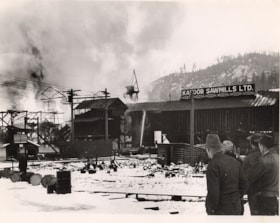
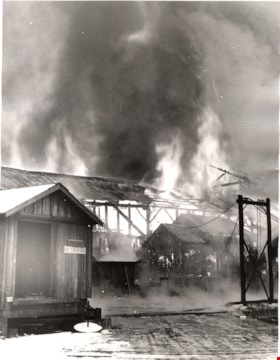
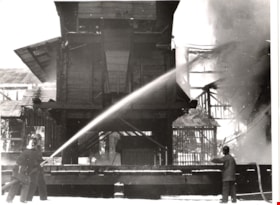
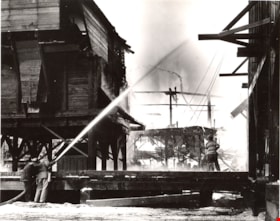
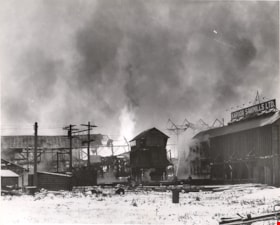
![Fleet of Kapoor Sawmills trucks, [194-] (date of original), copied 2004 thumbnail](/media/hpo/_Data/_BVM_Images/2019/2019_0032_0011_001.jpg?width=280)
